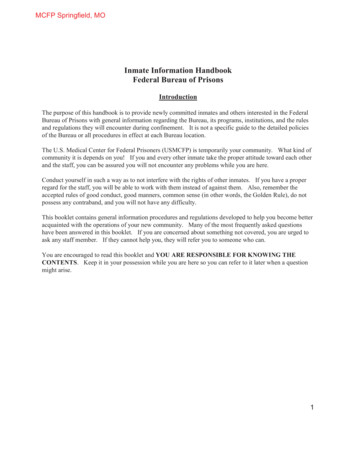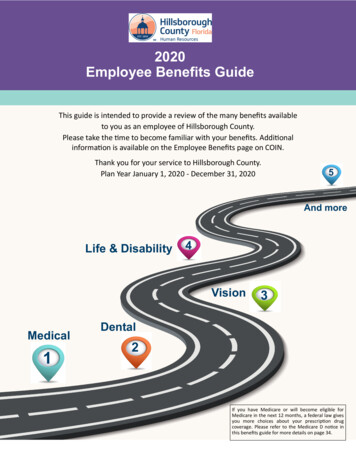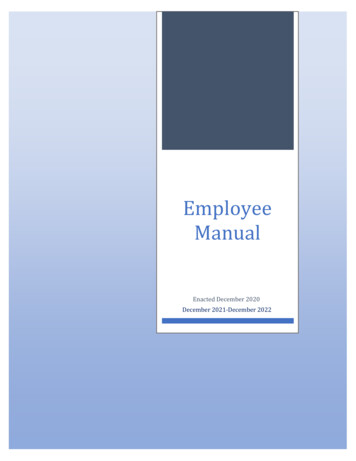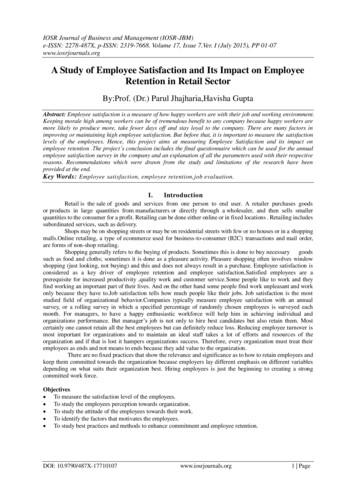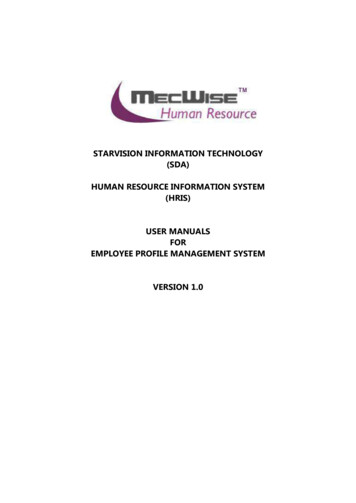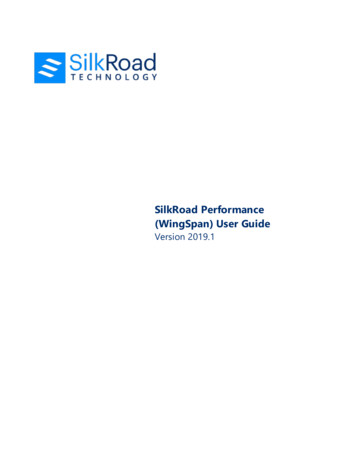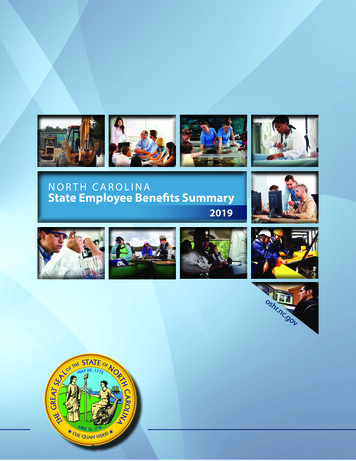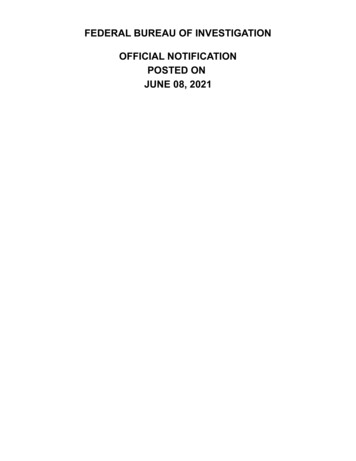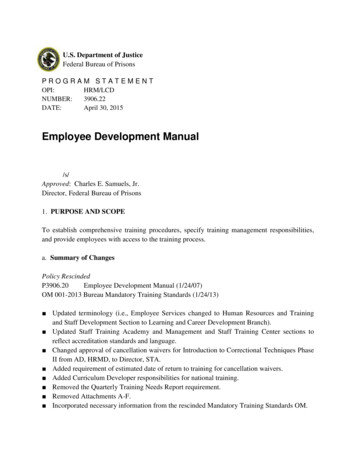
Transcription
U.S. Department of JusticeFederal Bureau of PrisonsPROGRAM STATEMENTOPI:HRM/LCDNUMBER:3906.22DATE:April 30, 2015Employee Development Manual/s/Approved: Charles E. Samuels, Jr.Director, Federal Bureau of Prisons1. PURPOSE AND SCOPETo establish comprehensive training procedures, specify training management responsibilities,and provide employees with access to the training process.a. Summary of ChangesPolicy RescindedP3906.20Employee Development Manual (1/24/07)OM 001-2013 Bureau Mandatory Training Standards (1/24/13) Updated terminology (i.e., Employee Services changed to Human Resources and Trainingand Staff Development Section to Learning and Career Development Branch). Updated Staff Training Academy and Management and Staff Training Center sections toreflect accreditation standards and language. Changed approval of cancellation waivers for Introduction to Correctional Techniques PhaseII from AD, HRMD, to Director, STA. Added requirement of estimated date of return to training for cancellation waivers. Added Curriculum Developer responsibilities for national training. Removed the Quarterly Training Needs Report requirement. Removed Attachments A-F. Incorporated necessary information from the rescinded Mandatory Training Standards OM.
b. Program Objectives. The expected results of this program are: Employees will receive the training needed for their current positions, as well as forprofessional growth and advancement. Human Resources Office responsibilities will be clearly defined.c. Institution Supplement. None required. Should local facilities make any changes outsidethe required changes in the national policy or establish any additional local procedures toimplement the national policy, the local Union may invoke to negotiate procedures orappropriate arrangements.2. ACTION REQUIREDStaff involved in employee training and staff development follow the procedures and meet thestandards in the attached Manual.3. AGENCY ACA ACCREDITATION PROVISIONS (See Program Statement DirectivesManagement Manual, Section 2.5 & 10.3) American Correctional Association, Standards for Adult Correctional Institutions, 4thEdition, 4-4073, 4-4074, 4-4075, 4-4076, 4-4077, 4-4078, 4-4079, 4-4080, 4-4082, 4-4083,4-4084, 4-4085, 4-4086, 4-4087, 4-4088, 4-4089, 4-4090, 4-4091M, 4-4093, 4-4094, 4-4229 American Correctional Association, Standards for Adult Local Detention Facilities, 4thEdition, 4-ALDF-4A-12, 4-ALDF-4D-08M, 4-ALDF-7B-05, 4-ALDF-7B-06, 4-ALDF-7B07, 4-ALDF-7B-08, 4-ALDF-7B-09, 4-ALDF-7B-10, 4-ALDF-7B-11, 4-ALDF-7B-12, 4ALDF-7B-13, 4-ALDF-7B-14M, 4-ALDF-7B-15M, 4-ALDF-7B-16, 4-ALDF-7B-17 American Correctional Association, Standards for the Administration of CorrectionalAgencies, 2nd Edition, 2-CO-1D-01, 2- CO-1D-02, 2-CO-1D-03, 2-CO-1D-04, 2-CO-1D-05,2-CO-1D-06, 2-CO-1D-07, 2-CO-1D-08, 2-CO-1D-09, 2-CO-1D-10 American Correctional Association, Standards for Correctional Training Academies, 1stEdition, 1-CTA-1A-01, 1-CTA-1A-02, 1-CTA-1A-14, 1-CTA-1A-15, 1-CTA-1D-03, 1CTA-3A-01, 1-CTA-3A-02, 1-CTA-3A-03, 1-CTA-3A-04, 1-CTA-3A-05, 1-CTA-3A-06, 1CTA-3A-07, 1-CTA-3A-08, 1-CTA-3A-10, 1-CTA-3A-11, 1-CTA-3A-12, 1-CTA-3A-13, 1CTA-3A-14, 1-CTA-3A-15, 1-CTA-3A-21P3906.224/30/20152
REFERENCESProgram StatementsP1600.09 Occupational Safety, Environmental Compliance, and Fire Protection (10/31/07)P3000.03 Human Resource Management Manual (12/19/07)P3713.24 Upward Mobility Program Central Office (07/17/08)P3906.18 Staff Mentoring Program (3/29/2002)P3939.07 Chaplains’ Employment Responsibilities and Endorsements (10/26/01)P5800.15 Correctional Systems Manual (01/01/09)Master AgreementBOP FormsBP-A0776BP-A1046Change Request to Mandatory Training StandardsTraining Course Code RequestRECORDS RETENTION REQUIREMENTSRequirements and retention guidance for records and information applicable to this program areavailable in the Records and Information Disposition Schedule (RIDS) on Sallyport.P3906.224/30/20153
ContentsChapter 1. Employee Development . 9CAREER ENHANCEMENT . 9STAFF DEVELOPMENT . 10CROSS-DEVELOPMENT SELF-STUDY . 10Chapter 2. Employee Development Planning . 12ANNUAL TRAINING PLAN . 12RESPONSIBILITIES . 13Chapter 3. Program Administration . 14TRAINING COMMITTEE . 14RECORDKEEPING . 15a. Cancellation Files . 15b. Program Evaluations . 15c. Training Records. . 15d. Training Authorization/SF-182 (TA)/Certification/Documentation. 15e. New Employee Documentation. . 16f. Annual Training (AT). . 16g. Program Review. 16h. Mandatory Standards Temporary Exemption. . 16i. Budget Information and other Administrative Records. . 16j. Training Opportunity Announcements (TOA). . 17APPLICATION PROCESS . 17CERTIFIED INSTRUCTORS . 18RECERTIFICATION . 18LEAD INSTRUCTOR . 19MSTC/STA STUDENT NOMINATION/CANCELLATION PROCEDURES . 19Chapter 4. Mandatory Training Standards . 21RESPONSIBILITIES . 21a. Central Office Divisions. . 21b. LCDB . 21c. HRO. . 21MANDATORY TRAINING STANDARDS REQUIREMENTS . 21SELF-STUDY. 21P3906.224/30/20154
TRAINING FOR TRANSFERRING EMPLOYEES . 22Employee Familiarization, Federal Bureau of Prisons, Transfers BOP Training (GNR0261-BXX). . 22FAMILIARIZATION TRAINING . 22Employee Familiarization Training (GNR-0260-BXX). . 22INTRODUCTORY CORRECTIONAL TRAINING . 22a. Correctional Training Program Phase I, Introduction – BOP . 22Course Code: CSV-0590-BXX. . 22b. Correctional Training Program, Phase II, Introduction – BOP . 23Course Code: HRM-0100-BXX. . 23ANNUAL TRAINING (AT) . 24Correctional Training, Annual – BOP (GNR-0150-BXX). . 24Chapter 5. Learning and Career Development Branch (LCDB) . 26NATIONAL TRAINING PROGRAMS. 26a. Site Selection. . 26b. Nominations/Selections. . 26c. Cancellation Procedures. . 26REQUESTS FOR NATIONAL POLICY ASSISTANCE . 27NATIONAL TRAINING PROGRAM FUNDING . 27CHANGES TO MANDATORY TRAINING STANDARDS . 28BOP-LEARN . 28COURSE CODE . 29Course Format . 29CURRICULUM DEVELOPMENT . 30a. Curriculum Design. . 30b. Curriculum Review. . 30EXECUTIVE DEVELOPMENT. 30a. Training Opportunity Announcement. . 31b. Program Evaluations. . 31c. Cancellations. . 31d. Training Authorization/Certification/Documentation. . 31e. National Institute of Corrections (NIC). . 32Chapter 6. Staff Training Academy (STA). 33INTRODUCTION TO CORRECTIONAL TECHNIQUES PHASE II (ICT Phase II). 33a. Scheduling. . 33P3906.224/30/20155
b. Cancellations. . 34c. Completion Requirements. . 34d. Motivational/Professional Category. . 36e. Student Failures. . 36f. Honor Graduates. . 36g. Participant Evaluations. . 37SPECIALTY TRAINING PROGRAMS . 37a. Nominations. . 38b. Scheduling Training Classes. . 38c. Scheduling. . 38d. Rescheduling/Cancellation. . 38e. Pass/Fail Policy. . 39MATERIAL REQUESTS . 39Chapter 7. Management and Specialty Training Center (MSTC) . 40MISSION, GOALS, ANNUAL REPORT. 40STRATEGIC PLAN . 40MSTC OPERATIONS . 40MSTC INSTRUCTORS . 40MSTC MASTER TRAINING SCHEDULE (ANNUAL TRAINING PLAN) . 41TRAINING MANAGEMENT . 41PARTICIPANT SELECTION . 42NOMINATION/CANCELLATION PROCEDURES FOR MSTC COURSES . 42a. Cancellations. . 42b. Training Waivers. . 43CORRESPONDENCE COURSES (HUMAN RESOURCES) . 43ASSESSMENTS . 44P3906.224/30/20156
GlossaryACA American Correctional AssociationAD Assistant DirectorAT Annual TrainingATP Annual Training PlanAW Associate WardenBOP Bureau of PrisonsBOP-Learn – Bureau’s Training Management SystemC&ID – Curriculum and Instructional DesignCDS Curriculum Development SpecialistCEO Chief Executive OfficerCPR/AED – Cardiopulmonary Resuscitation/Automated External DefibrillatorCR – Continuing ResolutionDAD Deputy Assistant DirectorDOJ Department of JusticeDTP Department/Division Training PlanEOD Entry on Duty (date)ETP Entry to Position (date)ED – Effective DateFLETC Federal Law Enforcement Training CenterHRA Human Resource AdministratorHRM Human Resource ManagerHRO Human Resources OfficeHRMD Human Resource Management DivisionICP Institution Character ProfileICT Phase I Introduction to Correctional Techniques Phase IICT Phase II Introduction to Correctional Techniques Phase IIJTA Job Task AnalysisLCDB Learning and Career Development Branch(formerly Training and Staff Development Section)LEAD Leadership Enhancement and DevelopmentLEOSA Law Enforcement Officers Safety ActMSTC – Management and Specialty Training CenterNCA – National Corrections AcademyNIC National Institute of CorrectionsOGC Office of General CounselPOC – Point of ContactPMSO – Position Management System On-LineRD Regional DirectorP3906.224/30/20157
SME Subject Matter ExpertSTA Staff Training AcademyTA Training AuthorizationTOA Training Opportunity AnnouncementUDC Unit Disciplinary CommitteeP3906.224/30/20158
Chapter 1. Employee DevelopmentThis chapter describes training initiatives related to employee development, including CareerEnhancement, Staff Development, and Computer-Based Self-Study.CAREER ENHANCEMENTThe Career Enhancement process assists the BOP and the employee by preparing him/her toassume positions of increased responsibility. It also helps employees seeking to become moreeffective in their positions or who wish to help others in their career development. HumanResources staff assist with career guidance techniques, assessment and development tools, andguidelines concerning staff development.Involvement in this program does not guarantee selection to a new position. Each employee isresponsible for his/her own development. In the Career Enhancement process, employeesshould: Set realistic career goals for themselves.Accurately assess his or her current skills.Receive feedback.Improve skills needed for job effectiveness.Supervisors and Managers are responsible for the development of their employees. Theemployee, if applicable, may request from their supervisor or manager to further assist theircareer by: Allowing time away from current duties to participate in development activities. Providing opportunities to serve in acting roles. Structuring work assignments to provide exposure to new aspects of work.The above opportunities will be offered to qualified employees in a fair and equitable manner.Employees are never required to attend agency-sponsored training unless in an appropriate paystatus.P3906.224/30/20159
STAFF DEVELOPMENTHuman Resource Managers (HRMs) encourage staff to continue their development, provideoptions, and guide employees through Career Enhancement activities.Possible sources include cross-development courses, web-based courses, distance learning, selfstudies, outside workshops, seminars, and other educational programs.When prudent, outside resources are utilized. This includes public and private agencies, privateindustry, and colleges and universities (e.g., training videos, self-study courses, and libraryresources).In some cases, an employee may wish to volunteer personal time to participate in careerenhancement activities, in accordance with the Fair Labor Standards Act (FLSA), as applicable.CROSS-DEVELOPMENT SELF-STUDYCross-development courses provide training to staff in areas outside of their disciplines. TheLCDB, along with Central Office Branch Chiefs, ensures that courses are developed, reviewed,updated, and made available to BOP sites.After the employee reviews the subject matter and completes course activities and/or skillchecks, he/she takes a computer-based test. All cross-development examinations areconsidered open-book unless otherwise stated. Human Resource staff must enter eZexamtest completion data onto the training record. Web-based cross-development coursesgiven through BOP-Learn will automatically be credited to the training record when thecourse is completed and a passing score is received. Current cross-development coursesinclude: Case Management.Correctional Services Management.Correctional Systems.Education/Recreation Services Management.Facilities Management.Food Service Management.Health Services Management.Human Resources and Staff Development.Managing Female Offenders.Information Technology Services.Privatization Management.P3906.224/30/201510
Program Review and Management Control.Psychology Services Management.Occupational Safety and Environmental Health Management.Religious Services Management.Residential Reentry (formerly Community Corrections Management)UNICOR Management.P3906.224/30/201511
Chapter 2. Employee Development PlanningTraining and other performance improvement initiatives are designed to meet the BOP’s missionand goals by promoting, providing, and coordinating staff development.Per Title 5 of the Code of Federal Regulations Part 410.201 and American CorrectionalAssociation (ACA) requirements, an Annual Training Plan (ATP) is formulated each year basedon an organizational needs assessment, conducted by each Human Resources Office (HRO) onan individual, departmental, and organizational level. Documentation must reflect the needsassessment process and support the ATP.ANNUAL TRAINING PLANThe Annual Training Needs Assessment is used to develop the ATP, which must be completedprior to (and used as justification for) the next fiscal year’s budget. All departments are requiredto submit a departmental needs assessment each year.The local ATP consists of training and developmental activities that support the BOP’s missionby improving employee effectiveness.The plan must be approved by the Training Committee (see requirements in Chapter 3); the finalapproving authority is the Chief Executive Officer (CEO). Only the CEO is required to approveplans for sites not required to have a Training Committee, per Chapter 3.The ATP is the strategic plan for each servicing HRO.The ATP serves as justification for requesting funds. It must be adjusted once budget allocationis received, and approved through the same process.The ATP is a working document; the HRM adjusts it to reflect changes, updates, replacements,and accomplishments. In addition to the Fund Control System, additions and deletions areshown in an attachment.The ATP has two categories: performance goals/improvement and supplies/equipment. TheATP identifies participants by name, title, or department and includes Course Name orDescription, Cost, Source of Funding, and Status (completed, canceled, etc.).P3906.224/30/201512
RESPONSIBILITIESImmediate Supervisor/Manager Meets with each employee yearly to determine individual needs assessments, prioritize, andreach agreement regarding the employee’s needs. The individual needs assessment is a “roadmap” of an employee’s training and development activities, including training to addressexisting skills and pinpoint areas where skills are lacking or must be developed. Forwards information to the Department Head for inclusion in the Department TrainingNeeds Assessment.Department Head/Regional Office Administrator/Central Office Section Chief Assesses department needs by assessing the effect the training/development will have on theemployee, department, and institution/office. Discusses with employees and supervisors their training and development needs. Submits a Department/Division Training Plan (DTP) to the HRM, with each training activityprioritized.Human Resource Manager Obtains plans, including specific justifications, from each department in the institution,administrative office, division, or Training Center. This should include all trainingregardless of cost or funding source, with the exception of mandated training assigned inBOP-Learn. Collects relevant documentation from the sources listed (and any other data from any sourcenot listed that has an impact and is unique to the location). Drafts the local ATP, using DTPs with other data relating to training. The ATP is reviewedby the Training Committee and submitted to the CEO for approval by June 1 of each year forbudget justification. The ATP for the Central Office is submitted to the Deputy AssistantDirector, Human Resource Management Division (DAD, HRMD).P3906.224/30/201513
Chapter 3. Program AdministrationThis chapter establishes a method of administrative operation in HROs and outlines an efficientorganizational structure. The administrative procedures describe the minimum management anddocumentation systems needed to create a historical base of information.Facilities for classroom instruction must be easily accessible, free from distracting noise orobservation by inmates, large enough to accommodate all students, and set up for audiovisualpresentations.TRAINING COMMITTEEA Training Committee must exist in all institutions (Regional Offices, Central Office, andTraining Centers excluded). The committee is chaired by the HRM. At a minimum, oneAssociate Warden (AW) must serve as a member; in his/her absence, acting representatives areappointed. In Complexes, an AW from each institution attends meetings. If the institution hasan employee who has completed the Innovative Learning Strategies (or Instructor Skills,Instructor) Program, that employee should serve as a member. In accordance with the MasterAgreement, the Union is afforded membership on the training committee.Per ACA requirements, regardless if an annual budget has been approved or not, the TrainingCommittee must continue to conduct quarterly meetings. Notification should be sent to alldepartment heads, executive staff, and the Union president via email. Minutes, reflectingcommittee discussions and decisions, must be signed by the Warden, routed to committeemembers, and kept on file for five years. HRMs are responsible for developing a process andform to review and approve training requested between meetings. Further, HRMs are required toensure the availability of the ACA Standards and other relevant information. The followingitems must be covered during the meeting and listed on the agenda: Review ATP and report to the committee all additions/deletions. Review training budget and receive approval from the committee for variances. Develop training based on issues that affect specific departments and the entire institution(e.g., Institution Character Profile [ICP], Strategic Planning, Joint Commission, ProgramReview, ACA, significant incidences.) Review program evaluations for effectiveness. Prioritize training requests (individual, departmental, and institutional) to formulate the ATP. Review and recommend approval/disapproval of training requests received by the HRO.P3906.224/30/201514
RECORDKEEPINGThe HRO keeps documents in this section on file for five years.a. Cancellation Files. The following cancellation documents are kept: Request for cancellation originating from the department head.Warden’s signed request for cancellation to the Regional Director.Regional Director’s (RD) (or designee’s) approval.Assistant Director, HRMD’s (AD, HRMD) (or designee’s) approval.b. Program Evaluations. Evaluation summaries are maintained for internal training programshosted by the HRO. Evaluations are reviewed, signed by the HRM and program instructor, andmaintained for five years.c. Training Records. Training records may be obtained through BOP-Learn by the employeeor requested through the HRO.d. Training Authorization/SF-182 (TA)/Certification/Documentation. Training conductedlocally must be keyed by Human Resources staff within 15 working days to ensure certificationsdo not expire in BOP-Learn. Training conducted by other departments or at other locations mustsubmit training documentation to the Human Resources Office (HRO) within 30 days after thecompletion of the training. Course codes, titles, dates, and hours are verified for accuracy beforebeing keyed into BOP-Learn. All training conducted nationally or by BOP training centers willbe keyed by the respective training center, unless specified in the TA.An obligating form (TA [SF-182], credit card document, or purchase order) is prepared forexternal training involving expenditures. The HRM signs SF-182s for his/her cost center, and allother obligating documents. It is not necessary to print a hard copy SF-182.For all non-departmental sponsored conferences/training, reference the Department of Justice(DOJ) policy 1400.01, Planning, Approving, Attending, and Reporting Conferences.Some form of input documentation must be used to initiate and certify training completion sign-in sheets, schedules, memorandums, or any document authorizing the training andcontaining all required information.Files containing keying documentation are maintained for five years. The HRM/HRS mayexercise discretion in keying non-mandatory training requests (e.g., lunch and learns, ActingP3906.224/30/201515
assignments, etc., of less than eight hours); however, consideration should be given to ensurestaff have satisfied the minimum required number of training hours annually.e. New Employee Documentation. The following documentation must be maintained for eachIntroduction to Correctional Techniques Phase I (ICT Phase I) and Introduction to CorrectionalTechniques Phase II (ICT Phase II) programs: Copy of ICT Phase I or New Employee Orientation training schedule/agenda.Course Evaluation (ICT Phase I or New Employee Orientation).Performance signoff sheets (ICT Phase I).ICT Phase II class evaluation (if applicable).f. Annual Training (AT). The following documentation must be retained: Agenda.Sign-in sheets.Dated employee roster.Medical exemptions (including a projected completion date), signed by the CEO.Firearms certification sheets/scores (for locations that complete firearms training).Curriculum (including lesson plans, PowerPoint presentations, and handouts). Specialcircumstances (location, security level, specialized programs, local statistics, etc.) mayrequire changes that are necessary to improve the effectiveness of AT. All changes to ATcurriculum (including lesson plans, presentations, additional worksheets and activities, etc.)must be approved by the CEO or designee prior to instructional use. Documentation o
P3906.20 Employee Development Manual (1/24/07) OM 001-2013 Bureau Mandatory Training Standards (1/24/13) Updated terminology (i.e., Employee Services changed to Human Resources and Training and Staff Development Section to

